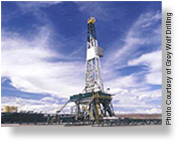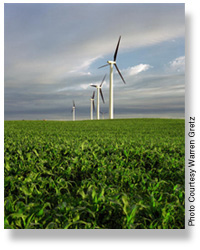This
article was prepared with information provided by the Department of
Energy's Wind Powering America Program.
Learn
More about Wind Energy's Benefits to the Rural Community
- American
Corn Growers’ Foundation
Learn more about the Foundation’s Wealth from the Wind program
athttp://www.acga.org.
Write to the foundation at P.O. Box 18157, Washington, DC 20036; or
call (202) 835-0330.
- Windustry
www.windustry.org
This organization partners with the Institute of Agriculture and Trade
Policy to promote wind educationand outreach. At the organization's
web site, under the section, "About Windustry", you may join the Wind
Farmers Network of America. You may write Windustry at 2105 First
Ave. South, Minneapolis, MN or call 800-946-3640.
- American
Wind Energy Association
AWEA offers information on policies that promote wind energy and provide
benefits to rural communities. Visithttp://www.awea.org;
write to The American Wind Energy Association at 122 C Street NW, Suite
380, Washington, DC 20001; or call 202-383-2500.
- Wind
Energy Resource Atlas
To find out whether you have a strong wind resource in your area, visit
http://rredc.nrel.gov/wind/pubs/atlas/.
#"> Home
Energy
Loans
Energy Statistics
mailto:energy1%40mail%2estate%2ene%2eus">
 State
of Nebraska Home
State
of Nebraska Home disclaimer.htm">
Disclaimer
feedback2.htm">Webmaster
 Dan McGuire, American Corn Growers Foundation
According to Dan McGuire, Wealth from the Wind program director for the
American Corn Growers Foundation, “Many farmers use irrigation wells with
natural gas engines. Farmers use propane for space heating and grain drying,
and propane's prices are tied to natural gas prices. Natural gas also
accounts for 80 percent to 90 percent of the cost of producing nitrogen
fertilizer (anhydrous ammonia). In March, prices for hydrous ammonia,
which is typically derived from natural gas, jumped from $185 per ton
a year earlier to $350 per ton and had only declined to $320 per ton by
May. Farmers' cost of production is affected by both the fuel and the
fertilizer variables.”
As Congress debates how to reduce our dependence on natural gas as well
as foreign oil, the President's National Energy Policy recommends “examining
the potential for greater electricity generation from sources other than
natural gas.” McGuire knows that wind energy fits the bill.
Dan McGuire, American Corn Growers Foundation
According to Dan McGuire, Wealth from the Wind program director for the
American Corn Growers Foundation, “Many farmers use irrigation wells with
natural gas engines. Farmers use propane for space heating and grain drying,
and propane's prices are tied to natural gas prices. Natural gas also
accounts for 80 percent to 90 percent of the cost of producing nitrogen
fertilizer (anhydrous ammonia). In March, prices for hydrous ammonia,
which is typically derived from natural gas, jumped from $185 per ton
a year earlier to $350 per ton and had only declined to $320 per ton by
May. Farmers' cost of production is affected by both the fuel and the
fertilizer variables.”
As Congress debates how to reduce our dependence on natural gas as well
as foreign oil, the President's National Energy Policy recommends “examining
the potential for greater electricity generation from sources other than
natural gas.” McGuire knows that wind energy fits the bill.
 “The impact of higher natural gas prices in 2003 had a tremendously
negative impact on corn farmers,” McGuire said. “The key is
to move the wind energy agenda at both the state and national levels,
including state and federal energy incentives, just as fast as possible.”
The
American Wind Energy Association predicts implementing policies that encourage
the growth of wind energy would create thousands of jobs and millions of
dollars in royalty income for hard-pressed farming and ranching states.
Wind projects also contribute to state business, sales, property and income
taxes. Thanks to wind energy, Pecos County, Texas, added $4.6 million to
its property tax revenue in 2002 alone. The increased revenue benefits local
services such as schools, health care facilities and roads. Farmers and
landowners in rural communities also benefit. Landowners in southern Minnesota
and northern Iowa who lease their land to wind developers receive annual
payments from $2,000 to more than $4,000 per turbine. Wind projects also
benefit rural economies by providing local jobs, from temporary construction
jobs during the initial phases of a project to permanent wind turbine maintenance
jobs.
In areas of the country where wind farms generate electricity, they are
directly helping to conserve natural gas supplies. And unlike natural
gas prices, which are subject to market fluctuations, wind energy costs
are predictable over time. Once a plant is built, the cost of producing
electricity is stable and the fuel source is free. This means that wind
energy works well in tandem with natural gas production. For example,
smart investors know that they should diversify their investment portfolios
and balance potentially high-risk stocks with more-conservative bonds
and mutual funds. Utilities devise a similar strategy to mitigate natural
gas price fluctuations and risks — they plan ways to use other energy
sources when natural gas prices soar. The fixed cost of wind energy helps
mitigate the rapidly fluctuating cost of natural gas in a utility's “portfolio.”
Soaring
Natural Gas Prices Are Here to Stay
“The days of $2 gas are gone,” Randall Swisher, executive director
of American Wind Energy Association, said, referring to the historical market
price for natural gas of just above $2 per 1,000 cubic feet prior to the
“The impact of higher natural gas prices in 2003 had a tremendously
negative impact on corn farmers,” McGuire said. “The key is
to move the wind energy agenda at both the state and national levels,
including state and federal energy incentives, just as fast as possible.”
The
American Wind Energy Association predicts implementing policies that encourage
the growth of wind energy would create thousands of jobs and millions of
dollars in royalty income for hard-pressed farming and ranching states.
Wind projects also contribute to state business, sales, property and income
taxes. Thanks to wind energy, Pecos County, Texas, added $4.6 million to
its property tax revenue in 2002 alone. The increased revenue benefits local
services such as schools, health care facilities and roads. Farmers and
landowners in rural communities also benefit. Landowners in southern Minnesota
and northern Iowa who lease their land to wind developers receive annual
payments from $2,000 to more than $4,000 per turbine. Wind projects also
benefit rural economies by providing local jobs, from temporary construction
jobs during the initial phases of a project to permanent wind turbine maintenance
jobs.
In areas of the country where wind farms generate electricity, they are
directly helping to conserve natural gas supplies. And unlike natural
gas prices, which are subject to market fluctuations, wind energy costs
are predictable over time. Once a plant is built, the cost of producing
electricity is stable and the fuel source is free. This means that wind
energy works well in tandem with natural gas production. For example,
smart investors know that they should diversify their investment portfolios
and balance potentially high-risk stocks with more-conservative bonds
and mutual funds. Utilities devise a similar strategy to mitigate natural
gas price fluctuations and risks — they plan ways to use other energy
sources when natural gas prices soar. The fixed cost of wind energy helps
mitigate the rapidly fluctuating cost of natural gas in a utility's “portfolio.”
Soaring
Natural Gas Prices Are Here to Stay
“The days of $2 gas are gone,” Randall Swisher, executive director
of American Wind Energy Association, said, referring to the historical market
price for natural gas of just above $2 per 1,000 cubic feet prior to the
 Randall Swisher,
Executive Director, American Wind Energy Association.
California electricity crisis of 2001. Instead, a price range of $4 to $5
per 1,000 cubic feet is expected, with regional shortages and occasional
spikes to $6-$10. Federal Reserve Board Chairman Alan Greenspan recently
testified to a U.S. Senate committee hearing on natural gas that no one
should expect a return of low prices in the near future.
Why are natural gas prices so high? First, domestic natural gas wells are
becoming “tapped out,” and even new, improved technologies can't
significantly increase production levels. Oil & Gas Journal reported
that Texas, which produces one-third of the nation's gas, must drill 6,400
new wells per year, or 17 wells per day, to keep its production from plummeting.
Randall Swisher,
Executive Director, American Wind Energy Association.
California electricity crisis of 2001. Instead, a price range of $4 to $5
per 1,000 cubic feet is expected, with regional shortages and occasional
spikes to $6-$10. Federal Reserve Board Chairman Alan Greenspan recently
testified to a U.S. Senate committee hearing on natural gas that no one
should expect a return of low prices in the near future.
Why are natural gas prices so high? First, domestic natural gas wells are
becoming “tapped out,” and even new, improved technologies can't
significantly increase production levels. Oil & Gas Journal reported
that Texas, which produces one-third of the nation's gas, must drill 6,400
new wells per year, or 17 wells per day, to keep its production from plummeting.
 Natural Gas Wells are becoming
“tapped out”
Proposed natural gas pipelines through Alaska and Canada are several years
away, and some question whether Canada, also faced with dwindling reserves
and rising natural gas prices, will continue to export increasing quantities
to meet the demand of its neighbor to the south. Importing liquefied natural
gas via tankers requires special port facilities, and only 1 percent of
America's natural gas is imported this way anyway. Many have voiced concerns
about security issues surrounding liquefied natural gas facilities near
metropolitan areas. These proposed solutions obviously cannot make a significant
dent in the present demand, and according to U.S. Secretary of Energy Spencer
Abraham, demand for natural gas is expected to rise by as much as 50 percent
over the next 25 years.
Second, natural gas reserves are lower than past inventories because last
winter was cooler than normal. Analysts worry that if this summer's heat
and consumer use of air conditioning increases, natural gas prices will
follow suit. Abraham said this year's challenge is to ensure adequate
natural gas supplies at prices consumers can afford.
“America's natural gas shortage affects everyone — from senior citizens
living on fixed incomes to small business owners trying to keep the lights
on,” Abraham said.
And that's where wind energy enters the picture. Electricity from the wind
can keep the lights on — and benefit rural communities at the same
time.
Natural Gas Wells are becoming
“tapped out”
Proposed natural gas pipelines through Alaska and Canada are several years
away, and some question whether Canada, also faced with dwindling reserves
and rising natural gas prices, will continue to export increasing quantities
to meet the demand of its neighbor to the south. Importing liquefied natural
gas via tankers requires special port facilities, and only 1 percent of
America's natural gas is imported this way anyway. Many have voiced concerns
about security issues surrounding liquefied natural gas facilities near
metropolitan areas. These proposed solutions obviously cannot make a significant
dent in the present demand, and according to U.S. Secretary of Energy Spencer
Abraham, demand for natural gas is expected to rise by as much as 50 percent
over the next 25 years.
Second, natural gas reserves are lower than past inventories because last
winter was cooler than normal. Analysts worry that if this summer's heat
and consumer use of air conditioning increases, natural gas prices will
follow suit. Abraham said this year's challenge is to ensure adequate
natural gas supplies at prices consumers can afford.
“America's natural gas shortage affects everyone — from senior citizens
living on fixed incomes to small business owners trying to keep the lights
on,” Abraham said.
And that's where wind energy enters the picture. Electricity from the wind
can keep the lights on — and benefit rural communities at the same
time.
 Southern Minnesota and Northern Iowa farmers lease their land to wind developers to recieve annual payments.
The
Wind Energy Solution
Energy experts estimate the current natural gas supply shortage amounts
to 3-4 billion cubic feet per day, and they cite the increasing use of gas
for electricity generation as one of the major causes of the shortfall.
According to Swisher, rapid expansion of the nation's wind turbine fleet
could sharply boost wind generation over the next four years, increasing
its output to the equivalent of 3 billion cubic feet per day, or about as
much natural gas as the states of Colorado and Alaska produce today.
“Wind plants can be permitted and built relatively quickly — typically,
within one to two years,” Swisher said. This presents a much more immediate
solution to the energy crisis than waiting for pipelines to be built or
ports to be retrofitted to handle liquefied natural gas.
And building wind plants makes good economic sense as well. In 2001, the
Colorado Public Utilities Commission ordered Xcel Energy, a regulated Colorado
utility company, to engage in good faith negotiations for a wind power plant
because the commission found that new wind generation would cost less than
new gas-fired power plants.
The American Wind Energy Association has proposed transmission plans for
30,000 megawatts of wind in the Midwest and West, which the group believes
is feasible in the near future. The wind industry has proposed a national
policy agenda to help avoid future power generation problems, including:
Southern Minnesota and Northern Iowa farmers lease their land to wind developers to recieve annual payments.
The
Wind Energy Solution
Energy experts estimate the current natural gas supply shortage amounts
to 3-4 billion cubic feet per day, and they cite the increasing use of gas
for electricity generation as one of the major causes of the shortfall.
According to Swisher, rapid expansion of the nation's wind turbine fleet
could sharply boost wind generation over the next four years, increasing
its output to the equivalent of 3 billion cubic feet per day, or about as
much natural gas as the states of Colorado and Alaska produce today.
“Wind plants can be permitted and built relatively quickly — typically,
within one to two years,” Swisher said. This presents a much more immediate
solution to the energy crisis than waiting for pipelines to be built or
ports to be retrofitted to handle liquefied natural gas.
And building wind plants makes good economic sense as well. In 2001, the
Colorado Public Utilities Commission ordered Xcel Energy, a regulated Colorado
utility company, to engage in good faith negotiations for a wind power plant
because the commission found that new wind generation would cost less than
new gas-fired power plants.
The American Wind Energy Association has proposed transmission plans for
30,000 megawatts of wind in the Midwest and West, which the group believes
is feasible in the near future. The wind industry has proposed a national
policy agenda to help avoid future power generation problems, including: